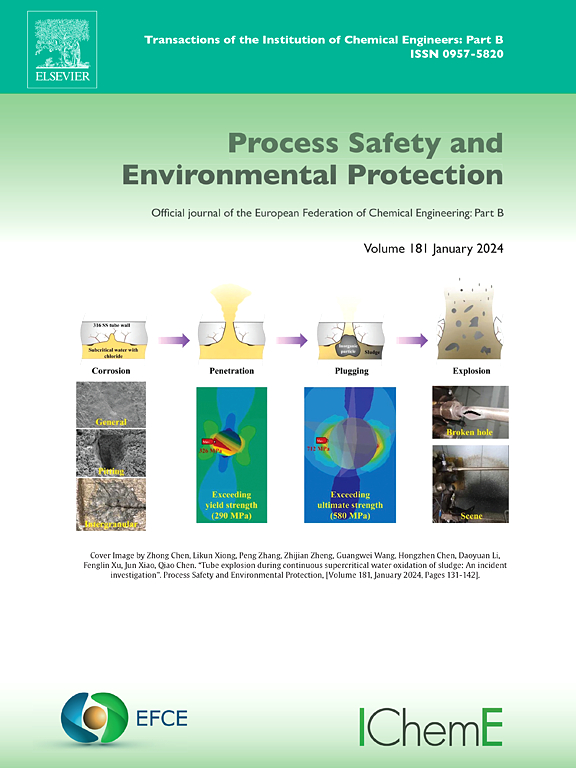废锰酸锂电池资源回收制备高性能锰基甲苯降解催化剂的构效关系研究
IF 6.9
2区 环境科学与生态学
Q1 ENGINEERING, CHEMICAL
引用次数: 0
摘要
为了解决废旧锂锰氧化物电池(LMO)和挥发性有机化合物(VOCs)带来的双重环境和健康挑战,本研究通过独特地将资源回收与功能催化剂设计相结合,开发了一种用于甲苯降解的3d结构复合锰氧化物催化剂,提供了一种将环境可持续性与卓越的催化性能相结合的创新解决方案。系统研究了渗滤液pH对催化剂晶体结构和催化性能的影响,深入分析了结构参数与催化活性之间的关系。与化学试剂制备的催化剂相比,废LMO制备的氧化锰表现出优异的性能。值得注意的是,复合晶体LMO-α@δ-MnO2具有三维结构,具有大量的氧空位,从而产生更高的低价锰和表面吸附氧。该材料还具有最小的晶粒尺寸、最大的孔体积、比表面积和最高的氧化还原能力,这有助于其对甲苯氧化的优异催化活性,达到218°C的T90。进一步探讨了甲苯在LMO-α@δ-MnO2上降解的潜在机理。本研究为废LMO资源的可持续利用和高效降解VOCs催化剂的开发提供了新的思路。本文章由计算机程序翻译,如有差异,请以英文原文为准。
Resource recovery from spent lithium manganese oxide batteries for the fabrication of high-performance manganese-based catalysts in toluene degradation: A structure-activity relationship study
To address the dual environmental and health challenges posed by spent lithium manganese oxide batteries (LMO) and volatile organic compounds (VOCs), this study developed a 3D-structured composite manganese oxide catalyst for toluene degradation by uniquely integrating resource recovery with functional catalyst design, offering an innovative solution that combines environmental sustainability with exceptional catalytic performance. The effects of leachate pH on the crystal structure and catalytic performance of the catalysts were systematically investigated, and the relationship between structural parameters and catalytic activity was thoroughly analyzed. Manganese oxide derived from spent LMO exhibited superior performance compared to similar catalysts from chemical reagents. Notably, the composite crystalline LMO-α@δ-MnO2 featured a 3D structure with numerous oxygen vacancies, resulting in higher low-valence manganese and surface-adsorbed oxygen. This material also had the smallest grain size, largest pore volume, specific surface area, and highest redox capability, contributing to its superior catalytic activity for toluene oxidation, achieving a T90 of 218°C. Furthermore, the potential degradation mechanism of toluene over LMO-α@δ-MnO2 was proposed. This study provides new insights into the sustainable resource utilization of spent LMO and the development of high-performance catalysts for VOCs degradation.
求助全文
通过发布文献求助,成功后即可免费获取论文全文。
去求助
来源期刊

Process Safety and Environmental Protection
环境科学-工程:化工
CiteScore
11.40
自引率
15.40%
发文量
929
审稿时长
8.0 months
期刊介绍:
The Process Safety and Environmental Protection (PSEP) journal is a leading international publication that focuses on the publication of high-quality, original research papers in the field of engineering, specifically those related to the safety of industrial processes and environmental protection. The journal encourages submissions that present new developments in safety and environmental aspects, particularly those that show how research findings can be applied in process engineering design and practice.
PSEP is particularly interested in research that brings fresh perspectives to established engineering principles, identifies unsolved problems, or suggests directions for future research. The journal also values contributions that push the boundaries of traditional engineering and welcomes multidisciplinary papers.
PSEP's articles are abstracted and indexed by a range of databases and services, which helps to ensure that the journal's research is accessible and recognized in the academic and professional communities. These databases include ANTE, Chemical Abstracts, Chemical Hazards in Industry, Current Contents, Elsevier Engineering Information database, Pascal Francis, Web of Science, Scopus, Engineering Information Database EnCompass LIT (Elsevier), and INSPEC. This wide coverage facilitates the dissemination of the journal's content to a global audience interested in process safety and environmental engineering.
 求助内容:
求助内容: 应助结果提醒方式:
应助结果提醒方式:


